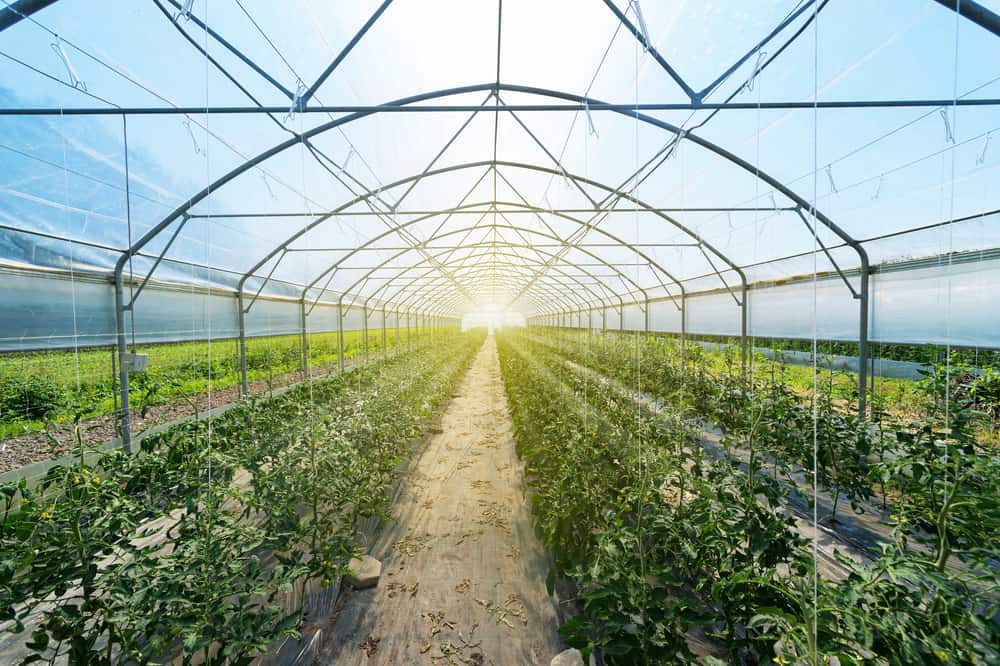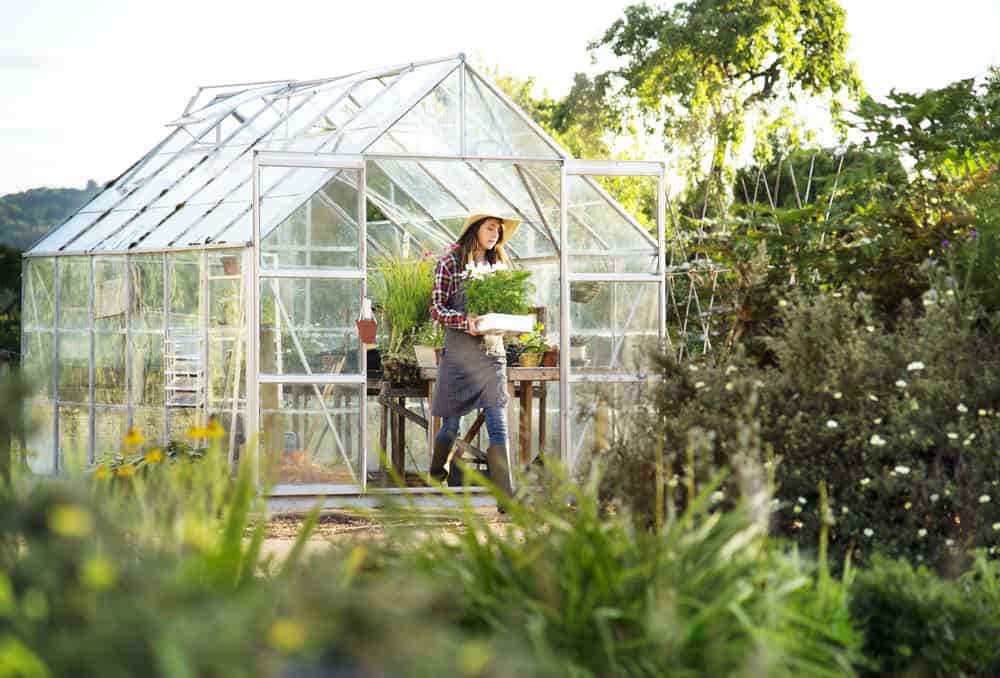Greenhouse
One of the greatest challenges that I faced when I first started vegetable gardening was getting the timing of my spring seedlings right. I’d enthusiastically plant the tomato, sweet pepper, and melon seeds at the first sign of spring and then watch with growing disappointment as only a handful germinated. I knew that a greenhouse was what I needed, but it seemed like such an intimidating investment at the time in terms of money and space. I found the perfect solution hiding in a dusty box in the garage – our camping tent!
A tent cannot be used as a greenhouse because tent fabric does not allow enough light for the plants to grow optimally. Greenhouses are designed to allow light in and trap heat, creating a micro-climate that enables plants to grow better than outdoors.
You may not be able to use a camping tent as a greenhouse as is; however, parts of a tent can be used to build a greenhouse quickly and inexpensively. Before you get started on building, it is essential to understand how a greenhouse works.z
What is a greenhouse?
A greenhouse is an outdoor structure covered on all sides, except the underside, in transparent material. Some greenhouses are permanent, built from metal or timber covered by glass or corrugated plastic. Other greenhouses are temporary, consisting of a structure like a tent covered by thick, transparent plastic.
How do greenhouses work?
Greenhouses allow light in, which heats the soil surface. This heat is trapped in the greenhouse material, creating a warm, humid environment in which plants can thrive. In warmer climates, greenhouses may heat up too much and may need a ventilation or cooling system. Greenhouses have flaps or windows that can be opened to allow heat to escape and fresh air to flow in and cool it.
Greenhouses should be constructed on a level surface in an area that receives sun throughout the day. They will not be effective heat traps if they are in an area that is too shady, especially for the first half of the day.
Benefits of growing in a greenhouse
Whether you garden purely to create a feast for the eyes or garden for the dinner table, a greenhouse can ensure that you have a fresh supply of blooms and vegetables all year round.
- Extends the growing season. In winter, when it is still too cold for warm-season plants, like citrus trees outside, a greenhouse provides a warm environment for plants to grow. Likewise, when temperatures start to decline in early fall, a greenhouse allows you to keep growing warm-season plants, like tomatoes, peppers, and melons for longer.
- Gives seedlings a head start. Spring seedlings can be given a head start by starting them in the greenhouse in early spring. This is highly beneficial as your plants will have more time to grow bigger before they are planted out, and they are protected from frost.
- Faster and better germination. Seeds need warm, moist conditions to germinate. A greenhouse creates a micro-climate that is optimal for germination.
- Fewer pests. Plants growing in a greenhouse are safer from pests such as slugs and snails because they are less exposed. However, this does not mean that greenhouses are immune to pests. If a greenhouse is too humid and there is not enough ventilation, powdery mildew and other fungal issues may arise.
Build a DIY greenhouse
Greenhouses are easy to build, and there are many different designs, ranging from simple to high-tech. You may already have many of the supplies you need to build a greenhouse lying around at home.
All greenhouses have two essential components: the structure and the cover. The structure can be wooden, bamboo, or plastic. Try to recycle things like a camping tent, hula hoops, or an old trampoline. The cover is what you may need to buy. You need a large enough sheet of transparent plastic to cover the structure, allowing some excess. Choose a thick, high-quality plastic so that you can reuse it the following season.

Turn a tent into a greenhouse
This method’s benefit is that you can use your tent poles for your greenhouse during winter and still use them when you go camping in summer!
- Step 1. Gather your supplies: an old tent with flexible fiberglass poles, a transparent plastic sheet, duct tape.
- Step 2. Insert the ends of the flexible poles along the sides of a raised bed so that the pole arc over the bed’s width, forming a tunnel structure. Ensure that the poles are pushed deep enough into the ground so that the structure is sturdy. If the soil is too sandy or does not have a raised bed, hammer a 20cm length of narrow PVC pipe into the ground and then insert the poles’ ends into the pipes.
- Step 3. Place the plastic sheet over the structure and secure it using duct tape. It helps to stick the tape on the inside of the greenhouse. Ensure that the plastic is evenly stretched.
- Step 4. Dig a trench about 30cm deep along the tunnel’s sides and bury the edges of the plastic sheet.
- Step 5. Fold the plastic neatly on either end of the tunnel, as if you are wrapping a giant gift, and secure the flaps with something heavy like rocks or bricks. Do it so that it is easy to regularly open the ends to vent the greenhouse and to work inside the space. For a permanent greenhouse, one could add a door with a frame and add vents that can be opened and shut with stick-on Velcro.
What can I use instead of a greenhouse?
If you do not have the space for a greenhouse but want to harness one’s benefits, you can create a mini greenhouse over your garden beds, called a caterpillar tunnel. Open old hula hoops and push the ends into the ground. Cover your tunnel structure with thick, transparent plastic, secure this with duct tape, weigh down the edges with rocks, or dig them in.
If your house has an exterior wall that is sunny all day long, you can use it to create a lean-to greenhouse using planks, ladders, bamboo poles, or whatever long objects you have lying around. Lean the objects against the wall, with the ends far enough away from the wall that there is space to grow seedlings. Cover the structure with thick, transparent plastic, using duct tape, and secure the edges with heavy objects like bricks. This creates a miniature greenhouse where you can give your seedlings a head start.
If you have a patio or windowsill garden, there is an even smaller greenhouse solution for you! Cut off the bottom of a transparent plastic bottle or jug, unscrew the lid and place the bottle over individual seedlings in your bed. The bottle will create the same effect as a greenhouse but on a smaller scale, trapping heat and humidity around the plant. The open lid allows for ventilation.
Indoor growing tents to grow vegetables
Another way to grow warm-season plants all year round is to invest in an indoor growing tent. These, unlike camping tents, have reflective material lining the interior. Growing tents are used together with growing lights and fans for ventilation. It is possible to monitor and control the temperature, humidity, and the duration of “daylight” hours in an indoor growing tent to create the ideal environmental conditions for whatever you are growing.
You must buy specialized growing lights, as regular lights that we use in our homes do not have the brightness and spectral range that plants require to grow, flower, and fruit. It is not advisable to use a camping tent as a substitute for a growing tent because their material is not thick enough to keep the light from escaping. Your whole house will have a pink glow, and your plants will not get the light intensity that they require to grow optimally.
Conclusion
While you cannot use a regular camping tent as a greenhouse, it is straightforward and inexpensive to use components of a tent to build your own greenhouse. The only thing one needs to buy is transparent, thick greenhouse plastic.
There are many ways to design and build a greenhouse. Be creative and try to use recycled materials as much as possible. The basic principles of a greenhouse are that it must allow light in, trap heat and allow for ventilation. Where you decide to build your greenhouse is very important. Choose a site that is sunny for most of the day.
An indoor alternative to a greenhouse is a growing tent. These are used together with specialized lights and fans that provide ventilation. Growing tent kits are widely available online and at most nurseries or hardware stores in various sizes. Some are small enough to fit inside a built-in cupboard!
